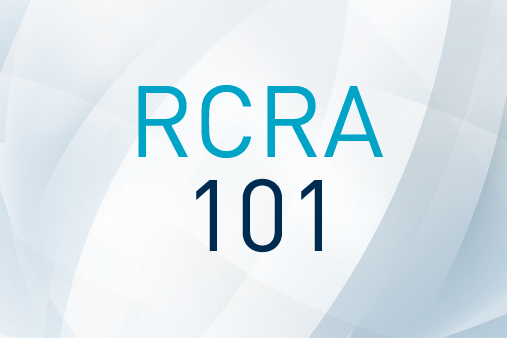CONTAINERS
Hazardous waste generators are required to put waste into containers that are compatible with the type of waste that is placed in them, to use containers that are in good condition, to properly label the containers, and to keep the containers closed.
COMMON CONTAINER VIOLATIONS INCLUDE:
- Listing incorrect or incomplete information on hazardous waste marks
- Missing the accumulation date (the date you first put waste into the container)
- Missing the words “Hazardous Waste”
- Missing the hazardous waste number
- Failing to keep the containers closed, except when waste is added or removed
- Leaving funnels in place that are not screwed into bung and do not have the capability of being kept closed
EMERGENCY PLANNING AND TRAINING
Hazardous waste generators are required to be prepared and able to respond to incidents involving hazardous waste releases and to report any releases under specific conditions.
COMMON PLANNING VIOLATIONS INCLUDE:
- Large Quantity Generators
- Missing current written Contingency Plan
- Missing, outdated, or incomplete emergency coordinator and other contact information including addresses and home phone numbers
- Missing list of emergency equipment and description of its capabilities
- Missing facility map showing location of emergency equipment
- Failing to include an evacuation plan that includes the signal to begin evacuation, evacuation routes and alternative evacuation routes
- Failing to mail plan to local emergency responders
- Failing to keep documentation that outside organizations, such as fire department, police, hospitals, local emergency planning committees, etc. were contacted
- Small Quantity Generators
- Missing, outdated, or incomplete emergency posting information by telephones
- Failing to make arrangements with outside organizations, such as fire department, police, hospitals, local emergency planning committees, etc., that would need to be called if an emergency occurred.
COMMON TRAINING VIOLATIONS INCLUDE:
- Missing or incomplete documented records of required training for Large Quantity Generators
- Missing job title
- Missing job description
- Missing employee name
- Missing written training description for Large Quantity Generators
- Failing to have Large Quantity Generator employees trained annually
- Using other emergency training programs required by other regulations, including videos or seminars, which do not have a portion clearly devoted to the hazardous waste requirements and do not cover the facility’s contingency plan
RECORD KEEPING
Hazardous waste generators are required to properly prepare, maintain, and submit copies of various records.
COMMON RECORDKEEPING VIOLATIONS INCLUDE:
- Failing to have a copy of manifests signed by the designated facility within the applicable timeframe
- Failing to send manifest copies within the applicable timeframe to your state’s Waste Management Division; and if sending to an out of state treatment, storage, and disposal facility, failing to send manifest copies to your state’s Waste Management Division and the other state agency
- Using wrong generator identification number on manifests or other reports (for example using a state identification number instead of the facility’s EPA identification number if they had been issued both numbers, or for those companies which have several sites, writing down another one of their site numbers instead of the site number where the waste was generated)
- Missing or incorrect waste codes or USDOT descriptions on manifests
- Missing copy of EPA’s biennial hazardous waste report for Large Quantity Generators
- Missing land disposal restriction (LDR) notification and waste analysis documents
- Missing or incomplete information on the LDR documents such as categories, underlying hazardous constituents, and manifest numbers
- Listing LDR information that is inconsistent with waste characterization
WASTE ACCUMULATION AREA
Hazardous waste generators have specific requirements regarding how and where they accumulate their hazardous waste, including requirements for satellite accumulation.
COMMON ACCUMULATION AREA VIOLATIONS INCLUDE:
- Failing to conduct weekly inspections. Missing or incomplete written documentation of inspections by Large Quantity Generators.
- Exceeding the allowable on-site accumulation time frame for hazardous waste.
- Having inadequate space or aisle width to properly inspect containers and for emergency personnel access.
- Failing to have labels visible for inspections.
- Leaving containers exposed to weather or vandals.
- Lacking or inadequate secondary containment including:
- Lacking or inadequate resistant coating and having cracked surfaces on secondary containment,
- Lacking or inadequate squirt protection, and
- Failing to have containers elevated or base of containment sloped to drain or sump, when required.
SATELLITE ACCUMULATION
Generators may choose to accumulate waste in limited amounts at or near the point of generation under specific conditions. This practice is commonly referred to as satellite accumulation
COMMON VIOLATIONS INCLUDE:
- Missing the words “Hazardous Waste” on container.
- Missing the hazardous waste number or chemical name that identifies the contents on container.
- Exceeding the allowable volume for each satellite site (total of 55 gallons of hazardous waste or one quart of acute or severely toxic hazardous waste).
- Failing to keep the container at or near the point of waste generation. Lacking operator control of the process that generates the waste that goes into the satellite container.
- Failing to keep satellite containers closed, except when waste is added or removed.
- Forgetting to list the date the satellite container(s) reaches the 55 gallons limit and failing to manage it under all the applicable hazardous waste accumulation area requirements within the allowable timeframe.
WASTE DETERMINATION
Hazardous waste generators are required to determine if the waste is a hazardous waste by either knowledge of the waste stream or by testing it, and to maintain records of that determination
COMMON DETERMINATION VIOLATIONS INCLUDE:
- Failing to properly identify all the hazardous waste generated at the business. Commonly overlooked wastes include, but are not limited to: partially empty aerosol cans, electric lamps, electronic equipment, batteries, antifreeze, rags and other textiles, sorbents, spent paint filters, spent activated carbon filter media, and sand blasting residue.
- Failing to have waste evaluations documented and to keep records for at least 3 years.
- Managing universal waste, such as electric lamps, mercury devices, batteries, and pesticides, incorrectly.

